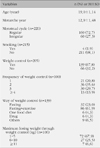Abstract
Purpose
The purpose of this study was to examine the bone mineral density (BMD), body mass index (BMI), stress, and health promotion lifestyle of female college students and to assess relations among them.
Methods
A total of 220 female college students were assessed through anthropometric measurements and bone mineral density test using quantitative ultrasound. In addition, the subjects were asked about stress and health promotion lifestyle with a self-rating questionnaire. Collected data were processed with the SPSS/WIN 12.0 program.
Results
1) Of the students, 67.8% had weight control experience. The percentage of the osteoporosis, osteopenia and normal groups were 2.8%, 53.5% and 43.8%, respectively, and the percentage of the underweight, normal and overweight groups according to BMI were 27.9%, 57.2% and 14.9%, respectively. 2) The levels of stress and health promotion lifestyle were 2.9 and 2.3, respectively. 3) There was a positive correlation between BMD and BMI (r=.196, p<.01). There was a negative correlation between stress and health promotion lifestyle (r=-.35, p<.01). 4) Weight control experience made negative effects on BMD and BMI.
Figures and Tables
References
1. Brener ND, Eaton DK, Lowry R, McManus T. The association between weight perception and BMI among high school students. Obes Res. 2004; 12(11):1866–1874.

2. Chang EY, Kim JS, Shin SJ. Health promotion lifestyle according to self-perception of obesity and objective status measured by bioelectric impedance analysis in college women. J Korean Acad Nurs. 2009; 39(5):693–699.

3. Cho DS, Lee JY. Bone mineral density and factors affecting in female college students. Korean J Women Health Nurs. 2008; 14(4):297–305.

4. Choi SN, Song CH, Kim SR, Chung NY. Bone density and related factors of university student in Seoul area. Korean J Food Cult. 2006; 21(6):596–605.
5. Chon MY, Kim MH, Cho CM. Predictors of health promoting lifestyles in Korean undergraduate students. J Korean Soc Health Educ Promot. 2002; 19(2):1–13.
6. Cohen S, Kamarck T, Mermelstein R. A global measure of perceived stress. J Health Soc Behav. 1983; 24:385–396.

7. Kang J, Kim YY, Kim M, Jung D. A study on body attitude, body mass index, and perceived stress among women's college students. J Korean Acad Public Health Nurs. 2009; 23(2):296–305.
8. Kim DY. Clinical application of bone mineral density measurement. Korean J Nucl Med. 2004; 38(4):275–281.
9. Kim H, Oh E, Hyong H, Cho E. A study on factors influencing health promotion lifestyle in college students. J Korean Acad Community Health Nurs. 2008; 19(3):506–520.
10. Kim IS, Paik YC. Relating factors influencing health promoting behavior of college women. J Korean Soc Matern Child Health. 2002; 6(2):245–256.
11. Kim JH. An effect of guided image applied to hemodialysis patients. Seoul: Seoul National University;1995. Unpublished doctoral dissertation.
12. Kim MH, Kim JS. The relationship between body composition and bone density in college women. J Korean Acad Nurs. 2003; 33(3):312–320.
13. Kim MS, Koo JO. Comparative analysis of food habits and bone density risk factors between normal and risk women living in Seoul area. Korean J Community Nutr. 2008; 13(1):125–133.
14. Kim OS, Yoon HS. Factors associated with weight control behavior among high school females with normal body weight. J Korean Acad Nurs. 2000; 30(2):391–401.
15. Lazarus RS, Folkman S. Stress, appraisal and coping. New York: Springer Publishing Company;1984.
16. Lee MO. Factors related to bone-density among postmenopause women. J Korean Acad Soc Nurs Educ. 2006; 12(2):214–223.
17. Lee PS. Correlational study among anger, perceived stress and mental health status in middle aged women. J Korean Acad Nurs. 2003; 33(6):856–864.

18. Mazess RB. Preventing osteoporosis. Br Med J. 1991; 303:921.
19. Moon T, Park S. A study on the relationships of demographic characteristics to stressor and stress coping behaviors among university students. J Sport Leis Stud. 2007; 30:913–925.
20. Pender NJ. Health promotion in nursing practice. 2nd ed. New York, Norwark: Conn, Appleton & Lange;1987.
21. Pender NJ. Health promotion in nursing practice. 3rd ed. Stanford: Appleton & Lange;1996.
22. Seo HM, Ha YS. A study of factors influencing on health promoting lifestyle in the elderly. J Korean Acad Nurs. 2004; 34(7):1288–1297.
23. Shin D, Chung N. Covert narcissism and fear of negative evaluation, body cathexis on binge drive for thinness. Korean J Health Psychol. 2007; 12(1):77–94.
24. Shin SJ, Shin KR, Kim EH. Health promoting lifestyle, stress and depression in college women. Nurs Sci. 2005; 17(1):40–47.
25. Sung M. Factors related to health promoting lifestyle in college women. J Korean Soc Sch Health. 2004; 17(2):97–105.
26. Sung M, Chang K. Correlations among life stress, dietary behaviors and food choice of college students. J East Asian Soc Diet Life. 2006; 16(6):655–662.
27. Ulla Diaz SM, Perez-Fortis A. Socio-demographic predictors of health behaviors in Mexican college students. Health Promot Int. 2010; 25(1):85–93.
28. Walker SN, Sechrist KR, Pender NJ. Health promoting lifestyle profile: Development and psychometric characteristics. Nurs Res. 1987; 36(2):76–81.
29. World Health Organization. Obesity and overweight. 2009. Retrieved February 20, 2009. from http://www.who.int/mediacenter/factsheets/fs311/en/index.html.
30. Yang SO. The diagnosis of osteoporosis. Paper presented at the meeting of the Korean Society of Bone Metabolism, The 4th summing-up in osteoporosis. Seoul. 2001.




 PDF
PDF ePub
ePub Citation
Citation Print
Print







 XML Download
XML Download